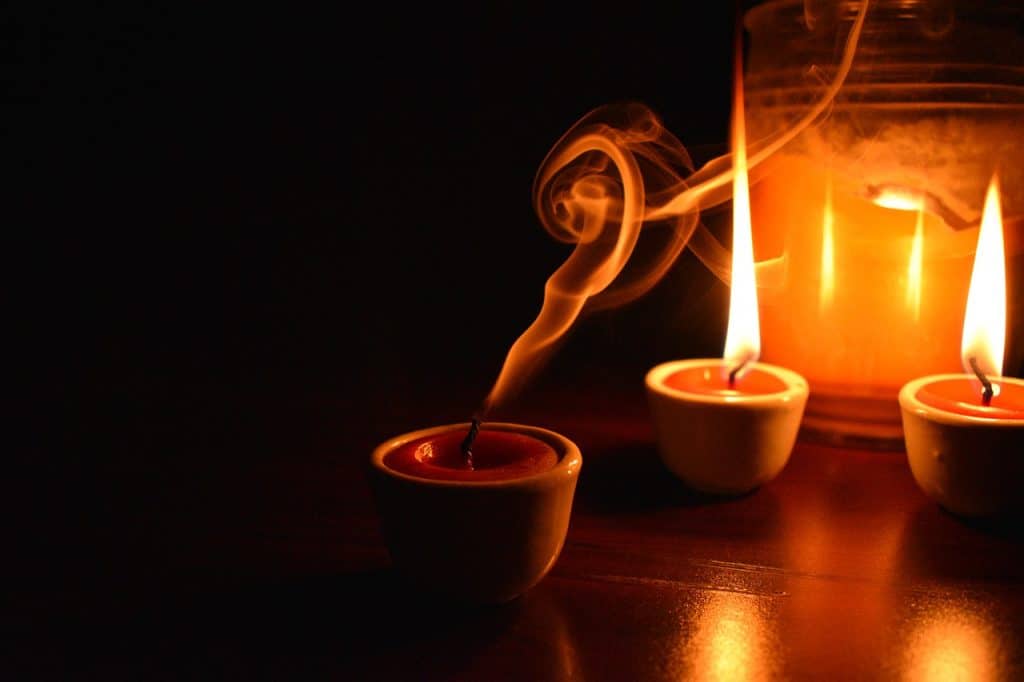Soy wax candles are used worldwide for their excellent scent throw, clean, and long burning hours. If a soy candle is made with 100% soybean, it can be called an “all-natural” soy candle. But soy candles are usually blended with paraffin or coconut wax as pure soy wax is not efficient for candle making.
Soy candles can encounter many problems: frosting, mottling, mushrooming wick, sweating, or wet spots. These problems can arise if the wax temperature is not maintained or too much fragrance oil is added. Each of the issues can be fixed, but we will look at “Sweating” for now.
Oil on the top of the container soy candle
Soy candles, particularly container candles, develop a thin layer of oil on the wax’s top. The possible reason for oil on the top of your container soy candle is “Sweating.”
Even our skin spills out excessive oil when the temperature changes. The only difference between human sweating and candle is that the soy candle usually sweats if a fragrance oil is mixed at a cooler temperature and when the temperature change is inconsistent.
The sweating might make the candle look ugly, but it doesn’t affect the candle’s quality or the burning.
Causes of oil on the surface of container soy candle
The soy wax can release the excessive fragrance oil it cannot hold with changing temperature. You might have noticed when you move your soy wax candle from one place to another with temperature differences, i.e., moved from air-conditioned storage to car/delivery truck and back to an air-conditioned room, the oil pops on the surface of the candle. It can also develop an oily layer when fragrance oil is not adequately mixed or stirred in the soy wax.
Thus, the two critical factors that are linked with sweating are;
- The temperature of the soy wax candle
- The fragrance oil
1- Temperature of the soy wax candle
The container soy wax candles are temperature sensitive. Sweating or oiling of the surface results from temperature variations of the environment they are poured, stored or burned.
The temperature should be periodically measured in the pouring pot before pouring it into the container. Recommended pour temperatures of soy wax average between 150 to 180 degrees Fahrenheit. Temperature can also vary depending on the container’s temperature in which the melted soy wax is poured; therefore it is better to preheat the container pot to homeostasis the temperature.
When the temperature changes consistently, the fragrance oil pools on the surface of the container candle. Sweating can still happen even if the difference is inconsistent, i.e., it is placed/burned in an environment with a cool breeze.
At what temperature should you pour candle wax?
The pour temperature (the temperature at which the candle is poured in a container and mixed with fragrance oil) plays an important role in binding fragrance oil with the melted wax. The pouring temperature of the melted wax depends on the type of wax.
The optimum temperature for soy wax as recommended by the candlemakers is 185 degrees Fahrenheit. The wax and the oil bind together completely and give out the best fragrance throw at this temperature. At a lower temperature, the biding would be affected. This would also affect the scent throw of the container soy candle.
2- Fragrance Oil
The oil leaches through the container candle’s surface if the fragrance oil is not mixed or binds with the wax ultimately. The fragrance oil is a concentrated mixture of essential oils (plant-derived-100 % natural) and aromatic compounds that burn longer. Not all fragrance oils are the best match for soy wax candles.
Being a concentrated solution, you must consider the quantity of the fragrance oil and the temperature at which it is mixed. Optimum temperature conditions and fragrance load ensure an excellent scent throw. The amount of the fragrance oil shouldn’t exceed the recommended limits. Usually, the soy wax candles constituent and best hold a fragrance load up to 10%.
The temperature is also crucial. Adding too much oil at too cool temperature can cause sweating (oil on the surface of container candle) and fragrance leaching (the essential oils’ fragrance). This is so because the fragrance oil would not bind with the wax molecules at cool temperatures.
Do the mixing of fragrance oil causes oil on the surface of the candle?
Another factor that you might want to consider would be the inappropriate mixing of the contents. Suppose you don’t stir the contents correctly. In that case, the fragrance oil won’t bind with the wax contents, and the oil can easily separate out shortly after temperature changes. Also, a strong fragrance escapes from the surface. Sometimes, this sweating can lead to soot/smoke production as well.
Thus, it is recommended to stir the contents (dye and fragrance) in the melted soy wax for about three to four minutes.
Recommendations for oil in container soy candle
In general, the wax can hold up to 10% of the fragrance oil. But, you can get a maximum scent throw with an optimal 7% fragrance load. You can balance the ratio as 1oz of fragrance oil per 1 pound (16 oz) of the soy wax in the standard rule of thumb. This would give a 6.25% fragrance load on average.
So, for a 7% fragrance load, use 1.12 oz of fragrance load. You can vary the percentages as per your desire.
Don’t Sweat about Candle Sweating
The oil on the top of the container candle might not look attractive. But you don’t have to panic or sweat after seeing a thin oil layer on your container soy wax candle. This is caused by some factors that we already discussed as temperature changes or excessive oils. But, the phenomenon neither affects the quality or the burning of the candle nor the scent throw.
You can prevent the oil on the surface of your container candle by following simple steps as follows;
For candle Maker:
- Choose the fragrance oil to add to the candle that would be the best fit for the candle.
- Low viscosity oil as Coconut lime essential oil and Salted caramel essential oil, with a strong scent throw, would bind efficiently with soy wax molecules.
- Heat the candle wax to an optimum temperature as recommended.
- Mix the color dye and fragrance oil with gentle stirring at an adequate temperature. The fragrance oil blends perfectly with the melted soy wax.
- Avoid air contact with the wax solution.
For Buyers:
- Do not buy candles that have too much fragrance oil. The maximum recommended fragrance load is 10%.
- You can clean the oil off the surface with tissue paper or paper towel like you wipe off your sweat.
- Store your container candle in a dry, cool place, away from windows and direct sunlight.
- When burned, place your container candles in an environment with a consistent temperature.
Frequently Asked Questions (FAQs)
How much fragrance should I add to soy wax?
The recommended fragrance load for a container soy wax candle is 10%. That means if you have 1 kg of soy wax, you will be needing 100 grams of fragrance oil in total.
At what temperature do I add fragrance oil to soy wax?
Heat the soy wax at 150 to 160 degrees Fahrenheit and add the constituents. Stir the contents gently and continuously to allow the perfect blending.
When Should I pour the soy wax into the container?
You should pour the melted soy wax into the container at a cooler temperature. Pour the candle wax gradually at around 130 degrees Fahrenheit. Pour it closer to the lid to avoid air contact and spills.
Conclusion
The candle making is based on balanced temperature. Multiple factors play a role in the candle-making process and affect scent throw. However, temperature and fragrance oil are most crucial in preventing the oil layer on container candles.
If you are making a candle(s), pay attention to recommended melt, pour temperatures, and fragrance load. And if you are buying a scented soy candle, read the label to get an insight into which fragrance oil is added and how much. Knowing these factors can help you avoid oily container candles and decide which soy candle is best for you.
Did you know that there are 16 different categories of candles?




